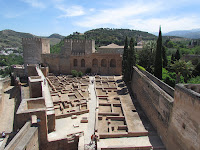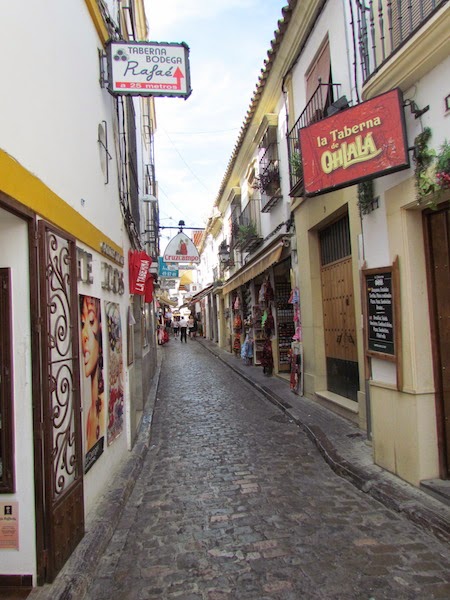Granada
Our second day-trip from Seville was to Granada, one of the eight provinces in the autonomous community of Andalucia. Granada is situated 260 kilometres east of Seville at the foot of the Sierra Nevada mountains. The main reason from our trip to Granada, was to visit the famous Alhambra and and adjoining Generalife Gardens.
The Alhambra
Many of the civilisations that inhabited Andalucia, left behind a cultural legacy that can only be described as incredible. One of these cultural legacies is the Alhambra, a palace and fortress built for the Muslin Emirs.
The history of the Alhambra dates back to 1237, when Mohammad I al-Ahmar, founder of the Nasrid dynasty ordered construction of the Alhambra. The Alhambra was built between 1237 and 1273, with the construction of the three palaces (the Nasrid Palaces - Mexuar Palace, Comares Palace and Palace of the Lions) taking place in different periods, with the last of the palaces being completed in 1391. Considered the jewel of the crown of Granada, the Alhambra (and Generalife) was declared a UNESCO World Heritage Site in 1984.
Before leaving for our trip to Spain, we were advised by some of our friends to book ahead, thus ensuring we would get tickets for the day we wanted to go there (there are only a limited number of tickets sold daily). When we went online to book our tickets, it showed that all the days we were available to visit the Alhambra were sold out. Our only other option if we wanted to visit the Alhambra, was to join a tour group. So we arranged beforehand to join a tour group and it turned out to be a great option, because our guide provided us with lots of information on the Alhambra and we got so much more out of our visit than had we gone on our own.
After the Alhambra was surrendered to the Catholic Monarchs in 1492, extensive repairs and alterations were done. Buildings like the Church of Santa Maria de la Alhambra and Palacio de Carlos V (Palace of Charles V, which today houses the Museum of the Alhambra and Museum of Fine Arts) were also constructed to form part of The Alhambra.
One of the most important and preserved areas of the Alhambra is the Nasrid Palaces. It is the only area of the Alhambra where visitors are assigned a specific time slot to visit (thus ensuring a limited number of visitors at the same time). Before entering the Nasrid Palaces, we were instructed that we were not to touch anything (including the walls, columns, plasterwork, decorative elements, latticework or plants) and we were even requested to carry our backpacks in the front of our bodies, so that nothing comes in physical contact with any aspect of the building.
It has been written that the last Nasrid Sultan cried when he left the Alhambra after being overthrown by the Catholic rulers and it is no wonder when you see the beauty of the magnificent courtyards and palace rooms. The Moorish style is everywhere and there is immaculate detail in everything, from the ceilings made of carved cedar wood representing the 7 heavens of Islamic religion, to the walls and columns ornamented with geometrical patterns and Arabic inscriptions. Truly beautiful and different to anything we have seen before in our travels.
After our visit to the Nasrid Palaces we had a short break from our tour, at which time David explored the Alcazaba while the rest of us sought shade in the gift shop. The Alcazaba is one of the oldest parts of the Alhambra and it is the military area of the complex. This section provided great panoramic views of the surrounding area.
After the break we headed to the last stop on our tour of the Alhambra, The Generalife. This area consists of the lower gardens, the upper gardens and the Palace of the Generalife. The Generalife was the recreation area of the Kings of Granada and it is a beautiful section with gardens and courtyards. These gardens were said to inspire many important musicians and writers, among them Washington Irving (author of Tales of the Alhambra).
Cordoba
After our visit to the Alhambra and the Generalife in Granada, we decided to drive to Cordoba. Cordoba is another one of the eight provinces in the autonomous community of Andalucia. Cordoba is situated about 200 kilometres north west of Granada and is home to the famous Mezquita and the ruins of Medina Azahara.
Situated on the banks of the river Guadalquivir, Cordoba has been inhabited by many different cultures in its long history, from the Romans and the Visigoths, to the Moors (North African Muslims) and Christians. It has also welcomed great philosophers like the Roman Seneca, great writers like Luis de Gongora and painters like Julio Romero de Torres. With its rich history, the historic centre of Cordoba has been declared a UNESCO World Heritage site.
After we arrived in Cordoba, we parked the car and then made our way through the maze of quaint streets with lovely buildings and shops, to the Mezquita.
After our visit to the Alhambra and the Generalife in Granada, we decided to drive to Cordoba. Cordoba is another one of the eight provinces in the autonomous community of Andalucia. Cordoba is situated about 200 kilometres north west of Granada and is home to the famous Mezquita and the ruins of Medina Azahara.
Situated on the banks of the river Guadalquivir, Cordoba has been inhabited by many different cultures in its long history, from the Romans and the Visigoths, to the Moors (North African Muslims) and Christians. It has also welcomed great philosophers like the Roman Seneca, great writers like Luis de Gongora and painters like Julio Romero de Torres. With its rich history, the historic centre of Cordoba has been declared a UNESCO World Heritage site.
After we arrived in Cordoba, we parked the car and then made our way through the maze of quaint streets with lovely buildings and shops, to the Mezquita.
The Mezquita is Cordoba's main monument and the most emblematic of the Spanish-Muslim culture. Work on this mosque started soon after the Moors arrived in Spain in 711, under the leadership of Emir Abd al-Rahman I, who made Cordoba the headquarters of the Emirate (in the 10th century Cordoba was the western capital of the Islamic empire - a place of learning, sophistication and wealth).
The Mezquita was built on the site of a Roman temple, which had been converted into a church by the Visigoths.
In 1236 Cordoba was conquered by the Christians and thereafter the Mezquita was consecrated as a Christian temple. Later, a Cathedral was built in the centre of the great building. That said, it is a unique building as the Cathedral is right in the middle of the mosque. Although it has been the city's cathedral since 1236, the locals still refer to it as "the Mosque"
Before we left Granada, we checked our guide-book and confirmed that the Mezquita closed at 7pm, so we had enough time to get to Cordoba and visit this site. Although we had every intention of visiting the Mezquita, by the time we arrived at the site at 5:15pm, it was closed. We could not find an explanation as to why the Mezquita was closed early that day and the people in the surrounding shops didn't seem to know either. Needless to say, we were disappointed that we could not go inside, but fortunately we could still explore some of the sights surrounding the Mezquita like the Puerta del Puente (Bridge Gate); Triunfo de San Rafael (a tall column with a statue of St. Raphael, the city's patron saint) and the Puente Romano (Roman bridge, a reminder of the city's Roman past).
Bar Santos started by Francisco Santos, is a small bar across the street from the Mezquita that is famous for its Spanish tortillas. A Spanish tortilla is a thick potato omelet that is made using potatoes, eggs, salt and olive oil. Up to this point David and I had tried Spanish tortillas in Madrid, but the ones we had tried were not as thick as the ones at Bar Santos, nor tasted as delicious. Bar Santos' Spanish tortillas went down well with our Tinto DeVaranos (red wine with Sprite/7-up or carbonated lemonade).
To end our day in Cordoba, we made a stop at Horno San Luis, a traditional bakery that makes and sells Pastel Cordobes. Pastel Cordobes is a traditional Cordoban cake that is made with puff pastry and sweet pumpkin. We bought a few slices to share and it was pretty good.
After our afternoon treat, we headed back to Seville 142 kilometres away.
After our afternoon treat, we headed back to Seville 142 kilometres away.



































































No comments:
Post a Comment